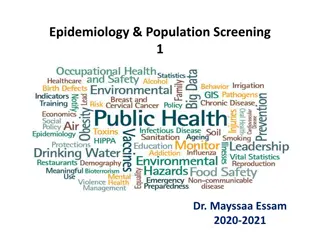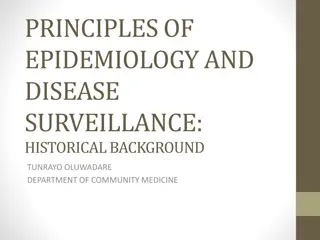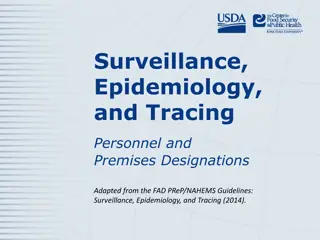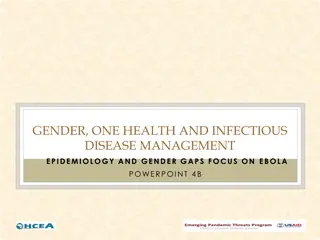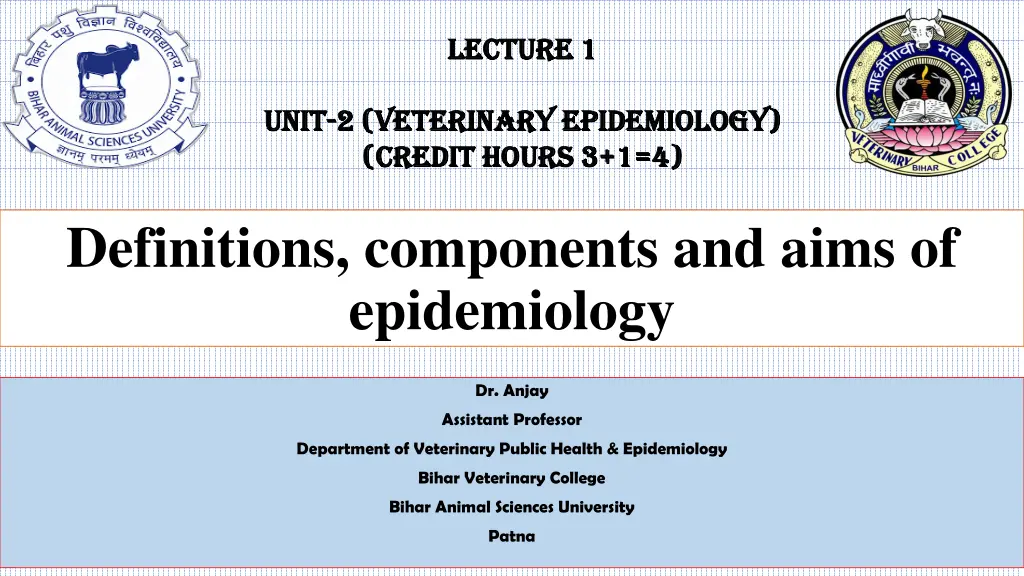
Veterinary Epidemiology: Definitions, Components, and Objectives
Explore the world of veterinary epidemiology, encompassing the study of disease in populations, factors influencing disease occurrence, historical perspectives, and crucial objectives such as disease origin determination and control planning. Dive into the origins of epidemiology, related terms like epizootiology, and the significance of observing animal populations for health-related inferences.
Download Presentation

Please find below an Image/Link to download the presentation.
The content on the website is provided AS IS for your information and personal use only. It may not be sold, licensed, or shared on other websites without obtaining consent from the author. If you encounter any issues during the download, it is possible that the publisher has removed the file from their server.
You are allowed to download the files provided on this website for personal or commercial use, subject to the condition that they are used lawfully. All files are the property of their respective owners.
The content on the website is provided AS IS for your information and personal use only. It may not be sold, licensed, or shared on other websites without obtaining consent from the author.
E N D
Presentation Transcript
Lecture 1 Lecture 1 UNIT UNIT- -2 (VETERINARY EPIDEMIOLOGY) 2 (VETERINARY EPIDEMIOLOGY) (Credit Hours 3+1=4) (Credit Hours 3+1=4) Definitions, components and aims of epidemiology Dr. Anjay Assistant Professor Department of Veterinary Public Health & Epidemiology Bihar Veterinary College Bihar Animal Sciences University Patna
Egyptian priest healers and the Vedic Salihotriya who founded the first veterinary hospitals. First permanent Veterinary school at Lyons in 1762 by Claude Bourgelat Quarentine: derived from the Italian Word meaning Fourty-the traditional length in days of isolation in middle age.
Epidemiology: definition and aims Epidemiology is the study of disease in populations and of factors that determine its occurrence. The basis of any epidemiological study is population in place of a single individual. Veterinary epidemiology additionally includes investigation and assessment of other health related events, notably productivity. All of these investigations involve observing animal populations and making inferences from the observations. Epidemiology is defined as the study of distribution of determinants of disease frequency in man. Mac Mohan and Pugh (1970). Study of pattern of disease. Halphin (1975). The research discipline concerned with the distribution and determinants of disease in the population Schwabe (1977). Ecology with their medical and mathematical flavor. Norman Levine (1990).
The term epidemiology originated from Greek words: i- (epi-) = upon, - (demo-) = people - (logo-) = discoursing Study of that which is upon the people or The study of disease in populations.
Epidemiology: related to studies of human populations Epizootiology: to the studies of animal (excluding human) populations. Greek - (zoo-) = animal Epidemics: Outbreaks of disease in human populations. Epizootics: Outbreaks of disease in animal populations. Epornitics: Outbreak of disease in avian populations. Greek i - (ornith-) = bird
Objectives of epidemiology Determination of the origin of a disease whose cause is known. Investigation & control of a disease whose cause is either unknown or poorly understood. Acquisition of information on the ecology & natural history of a disease. Planning, monitoring & assessment of disease control programmes. Assessment of the economic effects of a disease, & analysis of the costs & economic benefits of alternative control programmes.
Determination of the origin of a disease whose cause is known Any disease can be diagnosed on the basis of its history, clinical manifestations, laboratory tests (serological, molecular, other imaging techniques). It is however important to consider why a disease has occurred, what are the factors that contributed to the disease outbreak. e.g. A case of cutaneous Anthrax was observed in a postman. The lesions were present on the neck region. It was traced back to the use of a scarf which belonged to the postman s son who worked in a tannery.
Investigation and control of a disease whose cause is either unknown or poorly understood There are many instances of disease control based on epidemiological observations before a cause was identified. Edward Jenner advocated the protection of people against smallpox by using cowpox virus even before the virus was recognized as the etiological agent of smallpox. Contagious bovine pleuropneumonia was eradicated from USA in 1892 even before the etiological agent Mycoplasma mycoides was identified.
Acquisition of information on the ecology and natural history of a disease The three factors involved in a disease cycle are the agent, host and the environment. AGENT Host: An animal that is susceptible to & can be infected by an agent. Agent: Either infectious or non-infectious Environment: Aggregate of all external conditions and influences affecting the life and development of an organism and its behavior in the society. DISEASE HOST ENVIRONMENT
Natural history: Aggregate of all facts relating to animals and plants. Ecosystem: Related communities and their environment. Ecology: Study of ecosystem. e.g. Prevalence of Japanese encephalitis Prevalence of Fasciola hepatica
Planning, monitoring and assessment of disease control programmes Before adoption of any control measure it is important to address the following issues: The amount of disease in the population Factors associated with the occurrence of the disease Facilities required to control the disease The cost and benefits involved
Regular monitoring and surveillance is required to assess the effectiveness of a control strategy. It is also important to see if some new factors are affecting the occurrence of a disease. e.g. Eradication of dog rabies ..wild animal. Monitoring: Making of routine observations on health, productivity and environmental factors and recording and transmission of these observations. e.g. Regular meat inspection in an abattoir.
Surveillance:The ongoing systematic collection, analysis, and interpretation of outcome-specific data essential to the planning, implementation, and evaluation of public health practice, closely integrated with the timely dissemination of these data to those who need to know (Centers for Disease Control and Prevention, 2002) The continuous investigation of a given population to detect the occurrence of disease for control purposes, which may involve testing of part of a population (OlE, 2002). More intensive form of data collection than monitoring. Normal part of a disease control programme. e.g. Identifying an animal with TB lesions, trace back to the farm of origin, test other animals by tuberculin testing and then ascertain the level of disease for implementation of control programmes.
Assessment of the economic effects of a disease, and analysis of the costs and economic benefits of alternative control programmes Any control strategy being implemented must be economically more beneficial compared to the loss incurred on account of the loss in productivity, lives and cost of treatment. An economic analysis is therefore important before starting any control programme. If the prevalence of a disease is 20% then a control policy is advocated, while if the level is just 1% then treatment of the disease is economically a more viable option.
Aims of epidemiology 1) To describe the distribution and size of disease problems in human and animal population. 2) To identify the etiological factors in the pathogenesis of a disease. 3) To provide the data essential for planning, implementation and evaluation of services for the treatment, prevention, and control of a disease. (International Epidemiological Association)
THANKS FOR KIND ATTENTION






